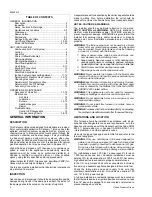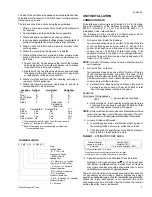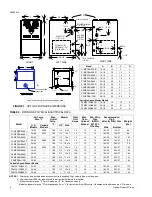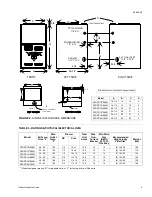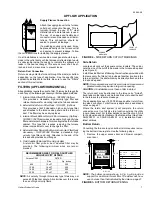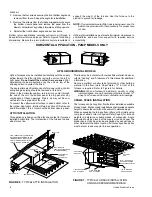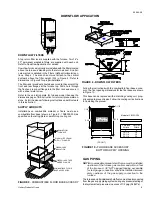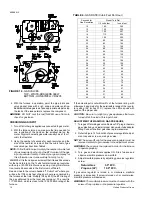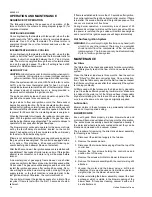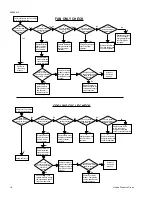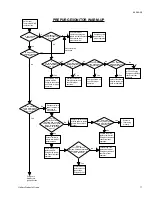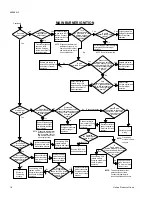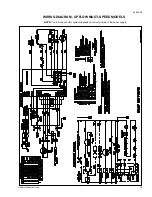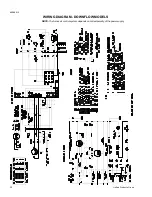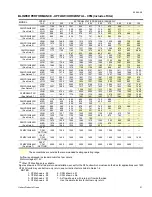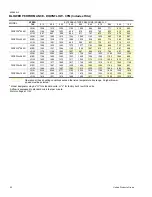
4. With the furnace in operation, paint the pipe joints and
valve gasket lines with a rich soap and water solution.
Bubbles indicate a gas leak. Take appropriate steps to stop
the leaks. If the leak persists, replace the component.
WARNING: DO NOT omit this test! NEVER use a flame to
check for gas leaks.
CHECKING GAS INPUT
1. Turn off all other gas appliances connected to gas meter.
2. With the furnace turned on, measure the time needed for
one revolution of the hand on the smallest dial on the
meter. A typical domestic gas meter usually has a 1/2 or 1
cubic foot test dial.
3. Using the number of seconds for each revolution and the
size of the test dial increment, find the cubic feet of gas
consumed per hour from Table 4.
NOTE: To find the Btuh input, multiply the number of cubic feet
of gas consumed per hour by the BTU content of the gas
in your particular locality. Contract your gas company for
this information, as it varies widely from city to city.
EXAMPLE: It is found by measurement that it takes 26 seconds
for the hand to turn on the 1 cubic foot dial to make a revolution
with only a 120,000 Btuh furnace running. Using this informa-
tion, locate 26 seconds in the first column of Table 3.
Read across to the column headed "1 Cubic Foot" where you
will see that 138 cubic feet of gas per hour are consumed by
the furnace at that rate. Multiply 138 by 850 (the BTU rating of
the gas obtained from the local gas company). The result is
117,300 Btuh, which is close to the 120,000 Btuh rating of the
furnace.
If the actual input is not within
±
2% of the furnace rating, with
allowance being made for the permissible range of the regula-
tor setting (0.3 inches W.C.), replace the orifice spuds with
spuds of the proper size.
CAUTION: Be sure to relight any gas appliances that were
turned off at the start of this input check.
ADJUSTMENT OF MANIFOLD GAS PRESSURE
1. Turn gas off at main gas valve. Remove 1/8" plug in the main
gas valve body and install proper manometer tube adapter
fitting. Connect line from gas valve tap to manometer.
2. Refer to Figure 14 for location of pressure regulator adjust-
ment cap and screw on main gas valve.
NOTE: The screw-off cap for the pressure regulator must be
removed entirely to gain access to the adjustment screw.
WARNING: The cap must be replaced in order for the furnace
to operate properly.
3. Turn gas and electrical supplies ON. Start furnace and
observe manifold pressure on manifold.
4. Adjust manifold pressure by adjusting gas valve regulator
screw.
If gas valve regulator is turned in, or clockwise, manifold
pressure is increased. If screw is turned out, or counterwise,
manifold pressure will decrease.
WARNING: The manifold pressure must be checked with the
screw-off cap in place on the pressure regulator.
Natural
Gas 3.5"
W.C.
Propane
(LP) 10.0"
W.C.
FIGURE 14 - GAS VALVES
TOP
-
WHITE-RODGERS
36E97
BOTTOM
-
HONEYWELL
VR8205
Seconds for
One Revolution
Size of Test Dial
1/2 cubic foot
1 cubic foot
10
180
360
12
150
300
14
129
257
16
113
225
18
100
200
20
90
180
22
82
164
24
75
150
26
69
138
28
64
129
30
60
120
32
56
113
34
53
106
36
50
100
38
47
95
40
45
90
42
43
86
44
41
82
46
39
78
48
37
75
50
36
72
52
35
69
54
34
67
56
32
64
58
31
62
60
30
60
TABLE 4 - GAS RATE (Cubic Feet Per Hour)
650.69-N3
12
Unitary Products Group


